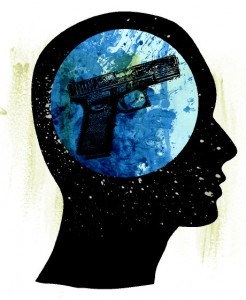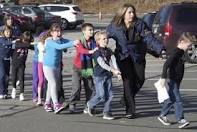I am writing this blog one day after the horrific massacre at a school in Newtown, Connecticut. Thus far it is known that a 24 year old man shot and killed his mother and then took three weapons including automatic assault rifle, dressed in combat gear and appeared at the school where his mother taught. He was recognized as the son of a teacher and was buzzed in. He then killed 4 adults including the principle who had recently instigated stricter security measures at the school and 20 students between the ages of 6 and 10 as well as himself. There was one report that he had some kind of argument at the school the day before the shooting. There are also descriptions that he was a troubled kid in school who had no friends and was very shy. He was said to be very bright in math. It was suggested that he may have had Asperger’s Syndrome and was on the Autism Spectrum. Another report said that he spoke of demons and therefore suggesting he may have been paranoid with schizophrenia. His parents were divorced after 17 years of marriage and his mother was reported as very protective. He has a brother at college.
I have no idea of his diagnosis and would not make any attempt to speculate on on the nature of his mental condition.
Psychological Trauma
 Common wisdom and research in this area tell us that the closer a person is to the traumatic event, the more likely and the more severe the psychological trauma will be. This however is a complicated issue. Certainly the adults and children who witnessed the shooting (including of course anyone wounded ) would be directly effected. This would include anyone in the school who heard sounds and participated in the terror of hiding and escaping from danger.
Common wisdom and research in this area tell us that the closer a person is to the traumatic event, the more likely and the more severe the psychological trauma will be. This however is a complicated issue. Certainly the adults and children who witnessed the shooting (including of course anyone wounded ) would be directly effected. This would include anyone in the school who heard sounds and participated in the terror of hiding and escaping from danger.
The two conditions that will emerge from such an incident are Acute Stress Disorder (ASD) and Post Traumatic Stress Disorder(PTSD) . According to the Diagnostic Manual of the American Psychiatric Association (DSM IV), the necessary requirement for both of these conditions must include the following :
The person has been exposed to a traumatic event in which both of the following were present.
1-The person experienced, witnessed, or was confronted with an event or events that involved actual or threatened death or serious injury or a threat to the physical integrity of self or others.
2- The person’s response involved intense fear, helplessness, or horror (in children, this may be expressed instead by disorganized or agitated behavior.)
In addition for us to make a diagnosis of ASD there needs to be three or more symptoms such as numbing, detachment, absence of emotional responsiveness or reduction in awareness of his or her surroundings (being in a daze) or derealization ( things don’t seem real) or depersonalization ( you don’t feel like yourself) , a tendency to re-experience the event by flashbacks, an avoidance phenomena related to recollection of the traumatic event, impairment of social and other areas of functioning, increased anxiety and arousal with sleep and concentration problems and a duration of these symptoms 2 to 4 weeks.
In order for us to make diagnosis of PTSD there needs to be similar symptoms as ASD with one or more symptoms of recurrent and intrusive recollections (manifested in young children by repetitive play), recurrent dreams, re-experiencing the traumatic event with illusions , hallucinations and flashbacks , physiological reactions, , persistent avoidance of stimuli associated with the trauma, numbing , efforts to avoid thoughts and feelings related to trauma, decreased interest or estrangement, inability to have loving feelings, insomnia, outbursts of anger , exaggerated startle response impairment in social functions, with a t least one of these symptoms lasting more than one month.
For more detailed and exact definitions see the DSM IV (or the new DSM V which may be somewhat revised )
Trauma Not Limited to Immediate Geographic Area
The development of these symptoms is not limited to people in the immediate vicinity.
Classmates who didn’t attend school that day can have symptoms as can people all over the world who are traumatized by accounts in the media which vividly reconstruct the events and allow others to identify with the victims. There will be very few school age children in the U.S. who will not have heard about the details of this event
I recall at the time of the Challenger disaster, we saw school children all over the country effected by seeing this spacecraft carrying the astronauts and some teachers disintegrate before their eyes on television . Similar situations have happened in other tragedies, which are covered, on TV.
Long Term Effects
It should be recognized that the acute and long term psychological effects of this trauma goes beyond the two disorders described above The experience also becomes woven in the psychological makeup of people who are impacted by it whether near or far where it happened . For some, the innocence of childhood is taken away . The sense of security is changed forever. Long after the acute symptoms are gone, the effects of this event will have changed the individuals who experienced it. In some cases it will be a determining factor in how they will mold their future lives. Perhaps they will always be a cautious person, looking for unexpected danger. In other ways, the trauma can motivate persons to become doctors, nurses, police, researchers or influence the way they view their own lives for better or worse.
The Need for Immediate Psychological Intervention;
 There has immediately been an outpouring of offers of psychological help.
There has immediately been an outpouring of offers of psychological help.
I am sure the school system ,local and state agencies will bring in counselors and therapists. Local mental health professionals will ofter their help. I know the Committee on Disasters of the American Psychiatric Association ( of which I have been a member ) has offered the local Psychiatric Society materials and information that can be useful . There has been offers from International Groups that have experience with these situations as well as from the Red Cross and from the nearby Yale Child Study Group. There will be individual and group meeting with the teachers and counselors as well with parents and of course with the children. The teachers will be trained how to be sensitive to the reactions of the children. It is important that all involved be aware of the various symptoms that can develop after events like this (some of which were described above) Danger signals need to be picked up. I am sure a wide variety of techniques will be used for one to one therapy as well as in groups. Talking in groups can be useful for many but for others individual sessions can be very helpful or a combination can be used. For some of the children, the comfort of discussions and interactions with their parents will be most important. Some parents will know how to handle this, other parents will benefit by discussion or counseling. I don’t believe there is one method which needs to be applied. The techniques used in individual and group treatment can cover a wide range from catharsis which involves expressing one’s experience and feelings, Cognitive Behaviors Therapy ( CBT) which uses correcting misconceptions and directly dealing with ideas and behavior and psychodynamic therapy where underlying meaning is explored and interpreted. In some acute situations medication (anti-anxiety or other stronger tranquilizers can be used and when conditions such as major depression is identified, antidepressants may be prescribed. Other techniques and combinations of approaches will be used especially the human support and caring offered by people near and far and by such groups as the Red Cross which will be quite useful and meaningful.
Grieving the Loss of Life.
 As most of us know grieving is a very intense process. Kubler-Ross described five stages of grief ; denial,, bargaining , anger , depression and acceptance. However, when there is unexpected death, traumatic death especially by murder and death of children, the grief takes on a different pattern which has been labeled Complicated Grief. We can expect the anger and depression to be greatly intensified and the duration of the intense emotions to be much more prolonged especially when there is the loss of a young child. Ultimately various types of memorials to the lost child which can give significances to the lost out life can be helpful
As most of us know grieving is a very intense process. Kubler-Ross described five stages of grief ; denial,, bargaining , anger , depression and acceptance. However, when there is unexpected death, traumatic death especially by murder and death of children, the grief takes on a different pattern which has been labeled Complicated Grief. We can expect the anger and depression to be greatly intensified and the duration of the intense emotions to be much more prolonged especially when there is the loss of a young child. Ultimately various types of memorials to the lost child which can give significances to the lost out life can be helpful
Concern About Other Disturbed Individuals Including Copycat Incidents
It is only natural that there will be concern on all levels that disturbed individuals who might do anything like this incident should be identified , receive help and be safely in a place where they can not harm anyone. This problem is accentuated at the time of such an incident and in the immediate aftermath since we know that sometimes in the mind of a severely mentally disturbed person, media reports of this event have the possibility of precipitating a copycat pattern of behavior in another disturbed person. The presence of mental illness is usually identified by family , friends and teachers at an relative early point in life. While there has been great progress in providing mental health care in the United States since the 1960s , there are still people who do not get the care that they need because of finances and the unavailability of services. Quality health care should be available to everyone and this includes those with mental illness.
The Overwhelming Majority of People with Mental Illness are Not Dangerous
Only a very small percentage of people with mental illness are a serious danger to other people. An incident such as this school shooting invariably unfairly intensifies the stigma towards people with mental illness. This can hinder recovery and adaptation to this condition. We need continued research in identifying people who could be dangerous and we also need to understand and educate the public about mental illness.
The Gun Control Issue and The Psychological Implications.
We don’t yet know the history and the story why the Connecticut shooter’s mother had registered guns in the house. I would guess that most probably if there were not these guns in the house ( which included automatic weapons ) that untold psychological trauma would not have occurred. The young man may have done something terrible but if guns were not available to him, the chances are, not as many people would have been killed.
I also wonder about the psychological effect of his growing up in a household where such guns were owned , kept and valued. I understand the argument that most gun owners may teach their children about gun safety. However when there are guns present, there may very well be the underlying message to a disturbed child, that when you are angry this is the way that you can act.
